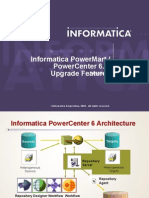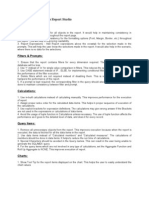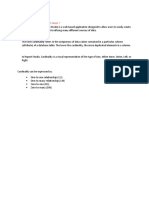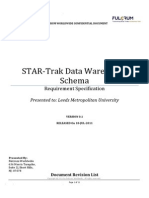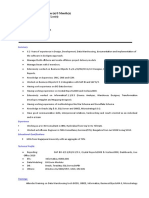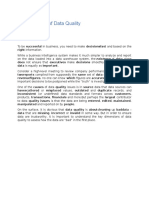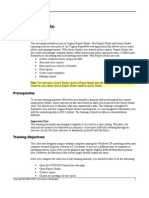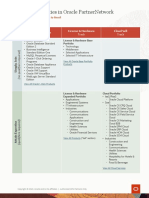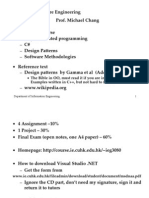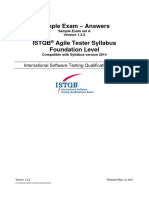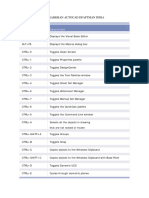0 ratings0% found this document useful (0 votes)
396 viewsBest Practices in Cognos Report Studio
Best Practices in Cognos Report Studio
Uploaded by
dhanz_99The document discusses best practices for developing reports in Cognos Report Studio. It recommends: 1) Consistency in formatting, using report expressions, and filters with '=' instead of 'in'; 2) Using built-in calculations, proper solve order, and brackets in expressions; 3) Removing unnecessary objects and using data items instead of calculated members/measures; 4) Defining tool tips and a single chart palette. Following these practices improves performance, readability, and maintainability of reports.
Copyright:
© All Rights Reserved
Available Formats
Download as PDF, TXT or read online from Scribd
Best Practices in Cognos Report Studio
Best Practices in Cognos Report Studio
Uploaded by
dhanz_990 ratings0% found this document useful (0 votes)
396 views4 pagesThe document discusses best practices for developing reports in Cognos Report Studio. It recommends: 1) Consistency in formatting, using report expressions, and filters with '=' instead of 'in'; 2) Using built-in calculations, proper solve order, and brackets in expressions; 3) Removing unnecessary objects and using data items instead of calculated members/measures; 4) Defining tool tips and a single chart palette. Following these practices improves performance, readability, and maintainability of reports.
Original Description:
Best Practices in Cognos Report Studio
Copyright
© © All Rights Reserved
Available Formats
PDF, TXT or read online from Scribd
Share this document
Did you find this document useful?
Is this content inappropriate?
The document discusses best practices for developing reports in Cognos Report Studio. It recommends: 1) Consistency in formatting, using report expressions, and filters with '=' instead of 'in'; 2) Using built-in calculations, proper solve order, and brackets in expressions; 3) Removing unnecessary objects and using data items instead of calculated members/measures; 4) Defining tool tips and a single chart palette. Following these practices improves performance, readability, and maintainability of reports.
Copyright:
© All Rights Reserved
Available Formats
Download as PDF, TXT or read online from Scribd
Download as pdf or txt
0 ratings0% found this document useful (0 votes)
396 views4 pagesBest Practices in Cognos Report Studio
Best Practices in Cognos Report Studio
Uploaded by
dhanz_99The document discusses best practices for developing reports in Cognos Report Studio. It recommends: 1) Consistency in formatting, using report expressions, and filters with '=' instead of 'in'; 2) Using built-in calculations, proper solve order, and brackets in expressions; 3) Removing unnecessary objects and using data items instead of calculated members/measures; 4) Defining tool tips and a single chart palette. Following these practices improves performance, readability, and maintainability of reports.
Copyright:
© All Rights Reserved
Available Formats
Download as PDF, TXT or read online from Scribd
Download as pdf or txt
You are on page 1of 4
1
Running the Report in Different Format
And Customize the Report Size
Author: Muhammad Shakir
Cognos Specialist
mshakir@segmentbi.com
www.segmentbi.com
SEG BI Consulting Services, Inc.
Transforming data into information
2
INDEX
Introduction 3
Best Practices-cognos report studio . 3
3
Introduction:
In this paper, we will discuss we will discuss some best practices that you should following while
working in cognos report studio.
Best Practices-cognos report studio:
Following are the points that the developer should use while developing reports in cognos
report studio.
1. Formatting:
Consistency
There should be consistency for the formatting options (Font, Margin,
Border, etc.) throughout the report. This will improve readability.
Report Expressions
Add Report expressions above the crosstab for the selection made in the
prompts. This will help the user know the selections made in the report; It
would also help in the scenario, where there is no data for the selections.
2. Filter and Prompts:
Ensure that there should be filters for every dimension required. Due to this
rows fetched from the database will be less.
Use = instead of in for single value comparison in filters. Due to this query
run time will reduce.
Use CASE statement instead of IFELSE, for implementing conditional
filter. This will improve performance of the filter execution.
Delete filters which are not required instead of disabling them. This is
required as unused Code hampers the performance of the report.
3. Calculation:
Use in-built calculations instead of calculating manually.
Assign proper solve order for the calculated data items.
Use explicit brackets for expression definitions. The calculations may give
wrong answer if the Brackets are not used in the expressions or calculations
of data items.
4. Query Items:
Remove all unnecessary objects from the report. This improves execution
because when the report is executed, the data is fetched for all the data
items in the report.
Use data items instead of Calculated members and Calculated
measures. The calculations of members should be done in data items. It
helps to reduce the run time of calculations.
4
Special Characters should be avoided in the Query names.
For the query items which are not involved in any type of calculations, set
the Aggregate Function and Roll up Aggregate to NONE.
5. Charts:
Show Tool Tip for the report items displayed on the chart.
Define single Palette for all the charts in the report. This helps to maintain
consistency for all the charts used.
6. General:
Use brackets in IFELSE, CASE. and other expression.
Minimum use of Java Script. Usage of Java script might affect the
performance of the report.
Use Render variable instead of Style variable to show or hide any report
items. Style variable executes the item on the report page and then hides it
but the render variable does not execute the item which is not to be
displayed in the report page.
Use Boolean variables instead of String variables unless string variables are
unavoidable. Boolean variables get executed faster as compared to String
variables.
You might also like
- Cloud-Based Data Analytics Platform Implementation Project ProposalDocument2 pagesCloud-Based Data Analytics Platform Implementation Project ProposalKasuni EDNo ratings yet
- Obiee Developers GuideDocument91 pagesObiee Developers GuideSiddhesh ThoratNo ratings yet
- SQL Server 2008 R2 Upgrade Technical Reference GuideDocument490 pagesSQL Server 2008 R2 Upgrade Technical Reference GuideshahvijuNo ratings yet
- ParjdevDocument1,130 pagesParjdevVineet Pal SinghNo ratings yet
- Datastage - Parameters - Schema FilesDocument23 pagesDatastage - Parameters - Schema FilesRMNo ratings yet
- Informatica Powermart / Powercenter 6.X Upgrade Features: Ted WilliamsDocument53 pagesInformatica Powermart / Powercenter 6.X Upgrade Features: Ted WilliamssrivardanNo ratings yet
- Informatica TransformationDocument86 pagesInformatica TransformationHanan AnsariNo ratings yet
- Oracle E-Business Suite Manufacturing & Supply Chain ManagementFrom EverandOracle E-Business Suite Manufacturing & Supply Chain ManagementNo ratings yet
- Config Making PART 1Document8 pagesConfig Making PART 1Natalie MadisonNo ratings yet
- Best Practices Report Studio GeneralDocument16 pagesBest Practices Report Studio Generalsubhabratapati_238No ratings yet
- Cognos Framework Manager Best PracticesDocument2 pagesCognos Framework Manager Best PracticesMonica Marciuc100% (1)
- Auto CascadingPrompts Without Page Refresh in IBM CognosReport StudioDocument11 pagesAuto CascadingPrompts Without Page Refresh in IBM CognosReport StudioclrhoadesNo ratings yet
- OBIEE - Dashboard Tips and Best Practice GuidelinesDocument6 pagesOBIEE - Dashboard Tips and Best Practice GuidelinesPani GummadiNo ratings yet
- COG-632: IBM Cognos 10 BI Metadata Model DeveloperDocument18 pagesCOG-632: IBM Cognos 10 BI Metadata Model Developergoutam16No ratings yet
- Cognos Interview QuestionsDocument148 pagesCognos Interview QuestionsanchalNo ratings yet
- Cognos Developer Resume Bayshore Ny PDFDocument6 pagesCognos Developer Resume Bayshore Ny PDFuser659nNo ratings yet
- DataStage MatterDocument81 pagesDataStage MatterShiva Kumar0% (1)
- Typical Interview QuestionsDocument11 pagesTypical Interview Questionssudas14No ratings yet
- Crystal Reports: - Kanagaraj K & Mahesh Sarathy PDocument51 pagesCrystal Reports: - Kanagaraj K & Mahesh Sarathy Pvenkat143786No ratings yet
- Star Trak Data Warehouse Schema v1 DraftDocument11 pagesStar Trak Data Warehouse Schema v1 DraftRio Puja LaksanaNo ratings yet
- OBIEE - Performance TuningDocument3 pagesOBIEE - Performance Tuningvenkatesh.gollaNo ratings yet
- Duckdb-Docs-0 9 2Document897 pagesDuckdb-Docs-0 9 2qgbr77x4ckNo ratings yet
- Datastage DeveloperDocument6 pagesDatastage DeveloperMohd JaweedNo ratings yet
- Get Off To A Fast Start With Db2 V9 Purexml, Part 2Document16 pagesGet Off To A Fast Start With Db2 V9 Purexml, Part 2Ankur VermaNo ratings yet
- OBIEE Performance TuningDocument9 pagesOBIEE Performance TuningVincenzo PetrucciNo ratings yet
- Junk DimensionDocument2 pagesJunk DimensionKatevarapu Venkateswara RaoNo ratings yet
- Total Experience: 6 Year(s) 0 Month(s) Annual Salary: Rs 7.0 Lac(s)Document7 pagesTotal Experience: 6 Year(s) 0 Month(s) Annual Salary: Rs 7.0 Lac(s)ramNo ratings yet
- OBIEE Bridge TableDocument3 pagesOBIEE Bridge Tablevenkatesh.gollaNo ratings yet
- Ibm Infosphere Datastage Performance Tuning: MenuDocument9 pagesIbm Infosphere Datastage Performance Tuning: MenuNisar HussainNo ratings yet
- Mahesh Babu Chintala's ResumeDocument10 pagesMahesh Babu Chintala's Resumebabjileo22No ratings yet
- UBS OCF - IDQ Capabilities ReviewDocument15 pagesUBS OCF - IDQ Capabilities ReviewAmarnathMaitiNo ratings yet
- Bridge TablesDocument6 pagesBridge TablesLawal Mobolaji MNo ratings yet
- SSRS Interview Questions (1) .OdtDocument11 pagesSSRS Interview Questions (1) .OdtravikumarNo ratings yet
- Databricks Certified Machine Learning Professional Exam GuideDocument9 pagesDatabricks Certified Machine Learning Professional Exam GuidemrtuntunNo ratings yet
- The Data WareHouse ETL Toolkit - Chapter 05Document40 pagesThe Data WareHouse ETL Toolkit - Chapter 05abacus83100% (1)
- BI Mini Project-Wardrobe AnalysisDocument11 pagesBI Mini Project-Wardrobe AnalysisAnushree ChandraNo ratings yet
- Presentation - 2018 - Microsoft SSIS SQL Server 2016&2017Document30 pagesPresentation - 2018 - Microsoft SSIS SQL Server 2016&2017Alberto KontadorNo ratings yet
- IDQ Functionality ImpDocument7 pagesIDQ Functionality ImpShiva CHNo ratings yet
- Cognos Impromptu by GopiDocument14 pagesCognos Impromptu by Gopipsaravanan1985No ratings yet
- Data Warehouse QuesDocument10 pagesData Warehouse Quesviswanath12No ratings yet
- SCIM Configuration in IICS AdminDocument16 pagesSCIM Configuration in IICS AdminOrachai TassanamethinNo ratings yet
- CognosDocument10 pagesCognosfriend0friend1friendNo ratings yet
- DAX Interview Questions 1697470822Document14 pagesDAX Interview Questions 1697470822iamrajatrai82No ratings yet
- Object Oriented Programming Lab-03 (GetterSetter, Constructors, MemberFunctions)Document4 pagesObject Oriented Programming Lab-03 (GetterSetter, Constructors, MemberFunctions)Ahmad AbduhuNo ratings yet
- Simon Looker - Curriculum VitaeDocument2 pagesSimon Looker - Curriculum VitaesimonlookerNo ratings yet
- Data Warehouses and Data CubesDocument21 pagesData Warehouses and Data CubesMukesh DagarNo ratings yet
- Table Partitioning in SQL ServerDocument11 pagesTable Partitioning in SQL ServermortinNo ratings yet
- 2416Document332 pages2416ksaikrishnaNo ratings yet
- Difference Between Fact Table and Dimension Table: Last Updated: 04 Sep, 2020Document2 pagesDifference Between Fact Table and Dimension Table: Last Updated: 04 Sep, 2020Niranjan Kumar DasNo ratings yet
- Cognos Report StudioDocument102 pagesCognos Report Studioapi-380055880% (5)
- Top 50 Informatica Interview QuestionsDocument7 pagesTop 50 Informatica Interview QuestionsHanan AnsariNo ratings yet
- Seminar Topic NosqlDocument73 pagesSeminar Topic NosqlAnish ARNo ratings yet
- The Snowflake Handbook: Optimizing Data Warehousing and AnalyticsFrom EverandThe Snowflake Handbook: Optimizing Data Warehousing and AnalyticsNo ratings yet
- Oracle SOA BPEL Process Manager 11gR1 A Hands-on TutorialFrom EverandOracle SOA BPEL Process Manager 11gR1 A Hands-on TutorialRating: 5 out of 5 stars5/5 (1)
- Relational Database Index Design and the Optimizers: DB2, Oracle, SQL Server, et al.From EverandRelational Database Index Design and the Optimizers: DB2, Oracle, SQL Server, et al.Rating: 5 out of 5 stars5/5 (1)
- 333aDocument18 pages333adhanz_99No ratings yet
- 444aDocument21 pages444adhanz_99No ratings yet
- 2Document2 pages2dhanz_99No ratings yet
- WorkDay Employee Hiring Process 02042014Document205 pagesWorkDay Employee Hiring Process 02042014dhanz_9933% (9)
- Workday M Raining Atalog PDFDocument12 pagesWorkday M Raining Atalog PDFdhanz_99100% (1)
- COGNOS Development Guidelines and Standards V1 2Document33 pagesCOGNOS Development Guidelines and Standards V1 2dhanz_99No ratings yet
- Electrical Machines 2 A-C Machines PDFDocument654 pagesElectrical Machines 2 A-C Machines PDFdhanz_99No ratings yet
- MA6251 Engineering Mathematics II Regulation 2013 Lecture Notes All Units PDFDocument99 pagesMA6251 Engineering Mathematics II Regulation 2013 Lecture Notes All Units PDFdhanz_99No ratings yet
- All Interview Questions Cognos IbmDocument13 pagesAll Interview Questions Cognos IbmKishore MaramNo ratings yet
- Lab 2Document3 pagesLab 2Devanshi GudsariyaNo ratings yet
- Win KeXDocument12 pagesWin KeXIVAN ANTONIO GARCIA FRANCONo ratings yet
- 3 Methods To Generate A PDF Output and Send Using Floe SAPDocument8 pages3 Methods To Generate A PDF Output and Send Using Floe SAPkoizak3No ratings yet
- Intro To WPFDocument38 pagesIntro To WPFUmar RashidNo ratings yet
- Resell Opportunities in Oracle Partnernetwork: Products Available For Partners To ResellDocument1 pageResell Opportunities in Oracle Partnernetwork: Products Available For Partners To ResellJoseph JosefNo ratings yet
- URLDocument21 pagesURLLyn Consing100% (3)
- Java Seminar - Grid LayoutDocument6 pagesJava Seminar - Grid LayoutPrashant SolankiNo ratings yet
- Exception Handling ProgramsDocument28 pagesException Handling ProgramsSasirekha PerumalvijayanNo ratings yet
- Remedy API Quick ReferenceDocument4 pagesRemedy API Quick ReferenceDileep PrabakarNo ratings yet
- Express HandbookDocument34 pagesExpress Handbookguillermo oceguedaNo ratings yet
- LogDocument49 pagesLogARCANGEL Airiel jhoiceNo ratings yet
- Beginners' Python: Based On Presented byDocument66 pagesBeginners' Python: Based On Presented byharutyunNo ratings yet
- Setup Steps For Retro-Notification ReportDocument4 pagesSetup Steps For Retro-Notification ReportgkumarraosNo ratings yet
- FATEKIoT IAccess Insight Manual enDocument15 pagesFATEKIoT IAccess Insight Manual enDragan ŠašićNo ratings yet
- C Exam Solutions PUDocument102 pagesC Exam Solutions PUDeepesh Adhikari100% (3)
- L3 Types Object EventDocument28 pagesL3 Types Object EventAryan KNo ratings yet
- HTML ConceptsDocument242 pagesHTML ConceptspankajNo ratings yet
- JVM JRE JDK Program Exe FlowDocument6 pagesJVM JRE JDK Program Exe Flowshubham gajbhiyeNo ratings yet
- The Principles of Abstraction Encapsulation Information-Hiding and ModularityDocument42 pagesThe Principles of Abstraction Encapsulation Information-Hiding and Modularitylamkakaka100% (1)
- Course Code: CSE3150 Course Title: Front End Full Stack DevelopmentDocument2 pagesCourse Code: CSE3150 Course Title: Front End Full Stack DevelopmentHarshithaNo ratings yet
- 19Sc1202 - Data Structures: B.Tech - Even Sem: Semester in Exam-I Academic Year:2020-2021 Set No: 5Document2 pages19Sc1202 - Data Structures: B.Tech - Even Sem: Semester in Exam-I Academic Year:2020-2021 Set No: 5Talasila AswanilathaNo ratings yet
- Jatin New Updated CVDocument3 pagesJatin New Updated CVToron TaatNo ratings yet
- ISTQB CTFL at Sample Exam Answers v1.2.2Document27 pagesISTQB CTFL at Sample Exam Answers v1.2.2iuliaibNo ratings yet
- Developing ASP - NET MVC 4 Web Applications - 20486BDocument17 pagesDeveloping ASP - NET MVC 4 Web Applications - 20486BRenier Serven50% (2)
- Software Engineering Prof. Rushikesh K. Joshi Computer Science & Engineering Indian Institute of Technology, Bombay Lecture - 18 Software Testing-IDocument27 pagesSoftware Engineering Prof. Rushikesh K. Joshi Computer Science & Engineering Indian Institute of Technology, Bombay Lecture - 18 Software Testing-Ikarishma10No ratings yet
- Autocad 2009 KeyDocument5 pagesAutocad 2009 KeyMohammed Abrar MiyanNo ratings yet
- Online Food Ordering Management System ProjectDocument17 pagesOnline Food Ordering Management System ProjectSul SyaNo ratings yet
- Tugas 3 MSIM4203 20221 PDFDocument9 pagesTugas 3 MSIM4203 20221 PDFDwi AnturiNo ratings yet
- Final Set-5Document32 pagesFinal Set-5Manas GhoshNo ratings yet





